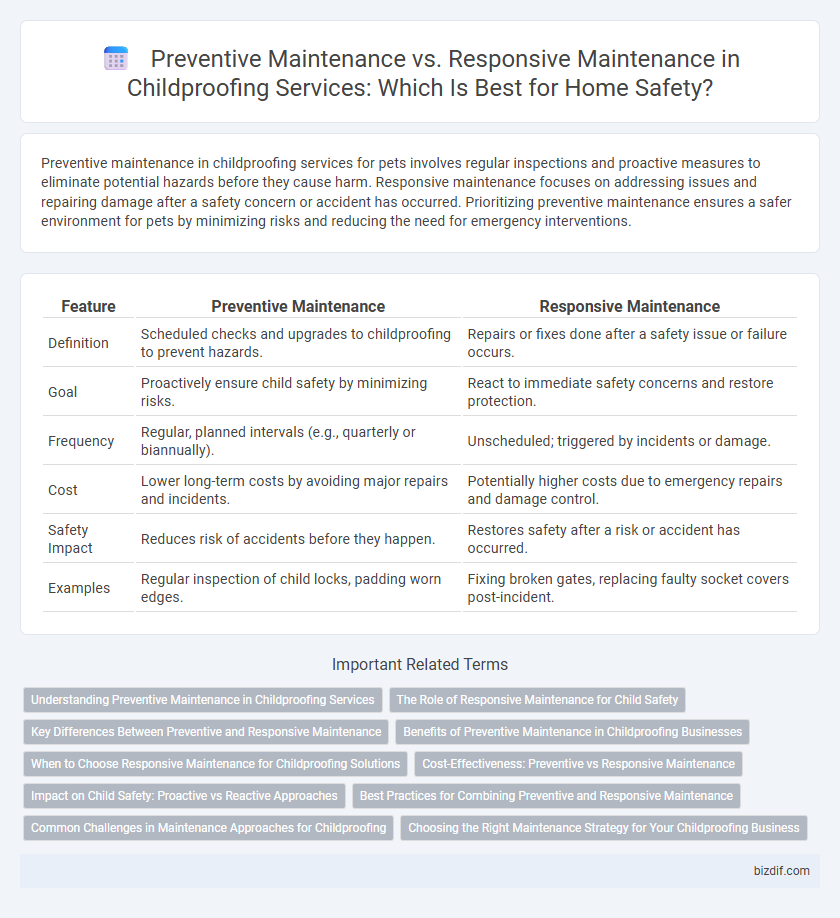Preventive maintenance in childproofing services for pets involves regular inspections and proactive measures to eliminate potential hazards before they cause harm. Responsive maintenance focuses on addressing issues and repairing damage after a safety concern or accident has occurred. Prioritizing preventive maintenance ensures a safer environment for pets by minimizing risks and reducing the need for emergency interventions.
Table of Comparison
| Feature | Preventive Maintenance | Responsive Maintenance |
|---|---|---|
| Definition | Scheduled checks and upgrades to childproofing to prevent hazards. | Repairs or fixes done after a safety issue or failure occurs. |
| Goal | Proactively ensure child safety by minimizing risks. | React to immediate safety concerns and restore protection. |
| Frequency | Regular, planned intervals (e.g., quarterly or biannually). | Unscheduled; triggered by incidents or damage. |
| Cost | Lower long-term costs by avoiding major repairs and incidents. | Potentially higher costs due to emergency repairs and damage control. |
| Safety Impact | Reduces risk of accidents before they happen. | Restores safety after a risk or accident has occurred. |
| Examples | Regular inspection of child locks, padding worn edges. | Fixing broken gates, replacing faulty socket covers post-incident. |
Understanding Preventive Maintenance in Childproofing Services
Preventive maintenance in childproofing services involves regular inspections and proactive upgrades to safety devices like outlet covers, cabinet locks, and corner guards, minimizing the risk of accidents before they occur. This approach ensures continuous protection by identifying and addressing potential hazards early, such as worn-out safety gates or loose window locks. By prioritizing preventive measures, families maintain a consistently secure environment, reducing emergency repairs and enhancing overall child safety.
The Role of Responsive Maintenance for Child Safety
Responsive maintenance plays a crucial role in childproofing by addressing safety hazards immediately after they are identified, reducing the risk of accidents at home. Unlike preventive maintenance, which schedules regular safety checks, responsive maintenance ensures quick repairs or adjustments to potentially dangerous elements such as broken locks, faulty electrical outlets, or unstable furniture. Timely intervention through responsive maintenance safeguards children by maintaining a consistently secure environment.
Key Differences Between Preventive and Responsive Maintenance
Preventive maintenance in childproofing involves regular inspections and scheduled upgrades to safety devices, minimizing risks before hazards occur. Responsive maintenance addresses issues only after identifying a safety concern, focusing on immediate repairs to restore protection. Key differences include timing, with preventive maintenance being proactive and reducing emergency interventions, while responsive maintenance is reactive and may lead to higher costs and increased safety risks.
Benefits of Preventive Maintenance in Childproofing Businesses
Preventive maintenance in childproofing businesses ensures ongoing safety by regularly inspecting and updating child safety products, reducing the risk of accidents before they occur. This proactive approach saves costs by avoiding emergency repairs and liability claims associated with faulty or outdated childproofing equipment. Consistent preventive measures enhance customer trust and satisfaction, positioning the business as a reliable provider in the child safety market.
When to Choose Responsive Maintenance for Childproofing Solutions
Responsive maintenance for childproofing solutions becomes essential when unforeseen hazards or damages arise, such as broken safety gates or malfunctioning cabinet locks that compromise child safety. Choosing responsive maintenance ensures immediate attention to these urgent issues, preventing potential accidents and maintaining a secure environment for children. Regular monitoring combined with prompt repairs addresses risks efficiently, making responsive maintenance a critical strategy in childproofing upkeep.
Cost-Effectiveness: Preventive vs Responsive Maintenance
Preventive maintenance in childproofing services involves regular inspections and proactive adjustments, significantly reducing the risk of accidents and costly repairs. Responsive maintenance addresses issues only after they arise, often leading to higher emergency costs and potential safety hazards. Investing in preventive childproofing ensures long-term cost-effectiveness by minimizing unexpected expenses and enhancing overall home safety.
Impact on Child Safety: Proactive vs Reactive Approaches
Preventive maintenance in childproofing involves regular inspections and timely updates to safety measures, significantly reducing the risk of accidents by addressing hazards before they cause harm. Responsive maintenance reacts to identified issues or incidents, which may lead to increased exposure to dangers and potential injuries in the interim. Prioritizing proactive childproofing strategies ensures a safer environment by minimizing risks through early detection and correction of safety threats.
Best Practices for Combining Preventive and Responsive Maintenance
Combining preventive and responsive maintenance in childproofing services ensures continuous safety by regularly inspecting and securing potential hazards while quickly addressing unexpected risks. Best practices include scheduling routine checks for safety installations like outlet covers and cabinet locks, alongside maintaining a rapid response system for repairing or replacing any damaged safety devices. This integrated approach minimizes downtime and maximizes child safety in both everyday environments and urgent situations.
Common Challenges in Maintenance Approaches for Childproofing
Preventive maintenance in childproofing involves regular inspections and proactive repairs to ensure safety devices like outlet covers and cabinet locks remain functional, minimizing risks before incidents occur. Responsive maintenance addresses issues after a safety device fails or is compromised, often causing delays in hazard mitigation and increased vulnerability for children. Common challenges include balancing timely repairs with thorough safety checks and managing costs while ensuring continuous protection in dynamic home environments.
Choosing the Right Maintenance Strategy for Your Childproofing Business
Choosing the right maintenance strategy for your childproofing business involves evaluating preventive maintenance, which focuses on regular inspections and proactive repairs to avoid hazards, versus responsive maintenance that addresses issues as they arise. Preventive maintenance enhances safety by minimizing risks associated with faulty childproofing equipment and reduces long-term costs by preventing major repairs. Responsive maintenance suits businesses with limited schedules but may lead to increased downtime and higher repair expenses due to delayed interventions.
Preventive maintenance vs Responsive maintenance Infographic

 bizdif.com
bizdif.com